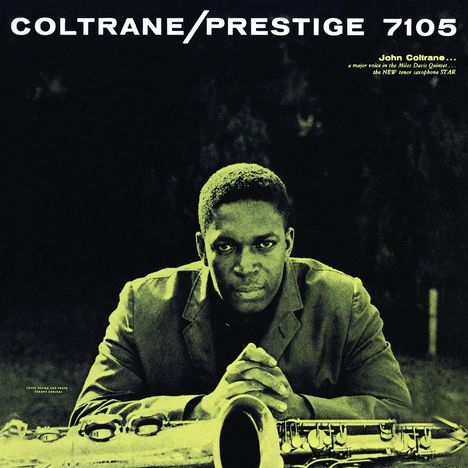John Coltrane: Coltrane (1957) (Rudy Van Gelder Remasters) auf CD
Coltrane (1957) (Rudy Van Gelder Remasters)
Herkömmliche CD, die mit allen CD-Playern und Computerlaufwerken, aber auch mit den meisten SACD- oder Multiplayern abspielbar ist.
Lassen Sie sich über unseren eCourier benachrichtigen, falls das Produkt bestellt werden kann.
- Label:
- Concord
- UPC/EAN:
- 0888072313415
- Erscheinungstermin:
- 30.6.2009
Weitere Ausgaben von Coltrane |
Preis |
|---|---|
| LP, (1957) (180g) (Limited Edition) | EUR 21,99* |
| LP, (1962) (180g) | EUR 21,99* |
| LP, (1957) (180g) (Mono) | EUR 19,99* |
| LP, (1957) (200g) (Mono) | EUR 47,99* |
| LP, (1957) | EUR 34,99* |
| CD, (1957) (SHM-CD), Japan-Import | EUR 17,99* |
Ähnliche Artikel
Coltrane - ursprünglich 1962 veröffentlicht - und als Bonus zwei Tracks aus der
selben Session, welche auf dem Originalalbum nicht enthalten waren.
John Coltrane zeigt alle aufregenden Elemente, die sowohl auf dem Tenor- als auch
auf dem Sopransaxophon Brillanz entfachten. Auf dem Album ist sein klassisches
Quartett mit dem Bassisten Jimmy Garrison, dem Schlagzeuger Elvin Jones und
anderen zu hören vor allem der herausragende McCoy Tyner, die zu diesem
Zeitpunkt alle bereits ihre leidenschaftliche Dynamik in das innere Ganze der Gruppe integriert hatten.
In writing of John Coltrane on the back of Mating Call, I took stock of his previous playing experience with Eddie Vinson, Dizzy Gillespie, Earl Bostic, Johnny Hodges, and Miles Davis. I wrote, “From his employment record you can see that he did not appear on the scene full blown. It is rather a matter of dues that he has been paying for a while.”
This is the age of the big build-up. Movie stars, television personalities, presidential candidates, soaps for use in washing machines; they are all sold to the public in the same manner. With the advent of hi-fi, the boom in long-playing records, and the discovery of “jazz” by Madison Avenue, musicians are getting similar treatment. Every other month we are greeted with albums by new stars. Some of them parlay a style and their publicity to a point of temporary popularity but then fail to stand even a short test of time.
John Coltrane is, in a sense, a new star but he has not arrived through high-pressure press agentry. He has been building on more solid ground. From the time of his joining the Miles Davis quintet in late 1955 through to his brilliant work with Thelonious Monk at the Five Spot Café in the summer of 1957, Trane has steadily increased his accomplishments on his instrument and gained new admirers for his playing among fellow musicians and the serious listening public. The very nature of his development and progress marks him not as a fly-by-night “star” who comes bursting across the sky and then fizzles out but as a definite addition to the select group of musicians who play influential roles through their ability to say something valid in a new way.
You have heard Coltrane on Prestige with Miles Davis, with Hank Mobley, with Sonny Rollins, the aforementioned Mating Call with Tadd Dameron, and Tenor Conclave. This, however, is his first date as a leader and in that role, Trane has chosen the musicians, contributed several compositions, and also has written some arrangements.
John Splawn, a young trumpeter from Harrisburg, Pennsylvania (born there on January 31, 1931), plays in the ensemble on four numbers and solos on two of these. His father, John Splawn Sr., is a trumpet player too. The elder Splawn, who is still gigging around Harrisburg, started Johnnie playing at about the age of five. Johnnie, who says he likes “everybody” on trumpet but “specially Brownie (Clifford Brown)”, has been with Sonny Stitt, Lou Donaldson, and, most recently, Bull Moose Jackson.
Sahib Shihab, the saxophonist who is best known for his alto work with Thelonious Monk in the Forties and Fifties and his baritone playing with Dizzy Gillespie in the Fifties, here appears on the larger horn in three selections. He is heard in solo on two of these. His is a deep, hard-toned voice which fits the needs of Coltrane’s and Cal Massey’s arrangements admirably.
Mal Waldron, at present Billie Holiday’s accompanist, and Red Garland, a Miles Davis quintet regular, split the piano assignment.
The remainder of the rhythm section remains constant throughout the entire session. On bass is the impeccable Paul Chambers from the Miles Davis group and on drums, Al Heath, younger brother of Percy, from Philadelphia where he has played with the best of the local musicians.
“Bakai” (which I’m told means “cry” in Arabic), by Cal Massey, opens side one. Its handsome minor theme is expounded by Red Garland, Coltrane (who really cries), and Shihab.
The rest of side one is handled by the quartet featuring Trane and Red. Two ballad standards, “Violet for Your Furs,” and “Time Was,” are the subjects; the former receives a sensitive ballad treatment while the latter is done in bright medium time.
Side two opens on “Straight Street,” a Coltrane composition and arrangement which features solos by the leader, Johnnie Splawn, and Mal Waldron.
An interestingly different Coltrane interpretation of the seldom-done “While My Lady Sleeps” is Trane’s alone until Splawn joins him for a final eerie note.
Trane’s “Chronic Blues” is the closer and gives all the horns and Waldron solo room.
-Ira Gitler
-
Tracklisting
-
Mitwirkende
Disk 1 von 1 (CD)
-
1 Bakai
-
2 Violets For Your Furs
-
3 Time Was
-
4 Straight Street
-
5 While My Lady Sleeps
-
6 Chronic Blues








